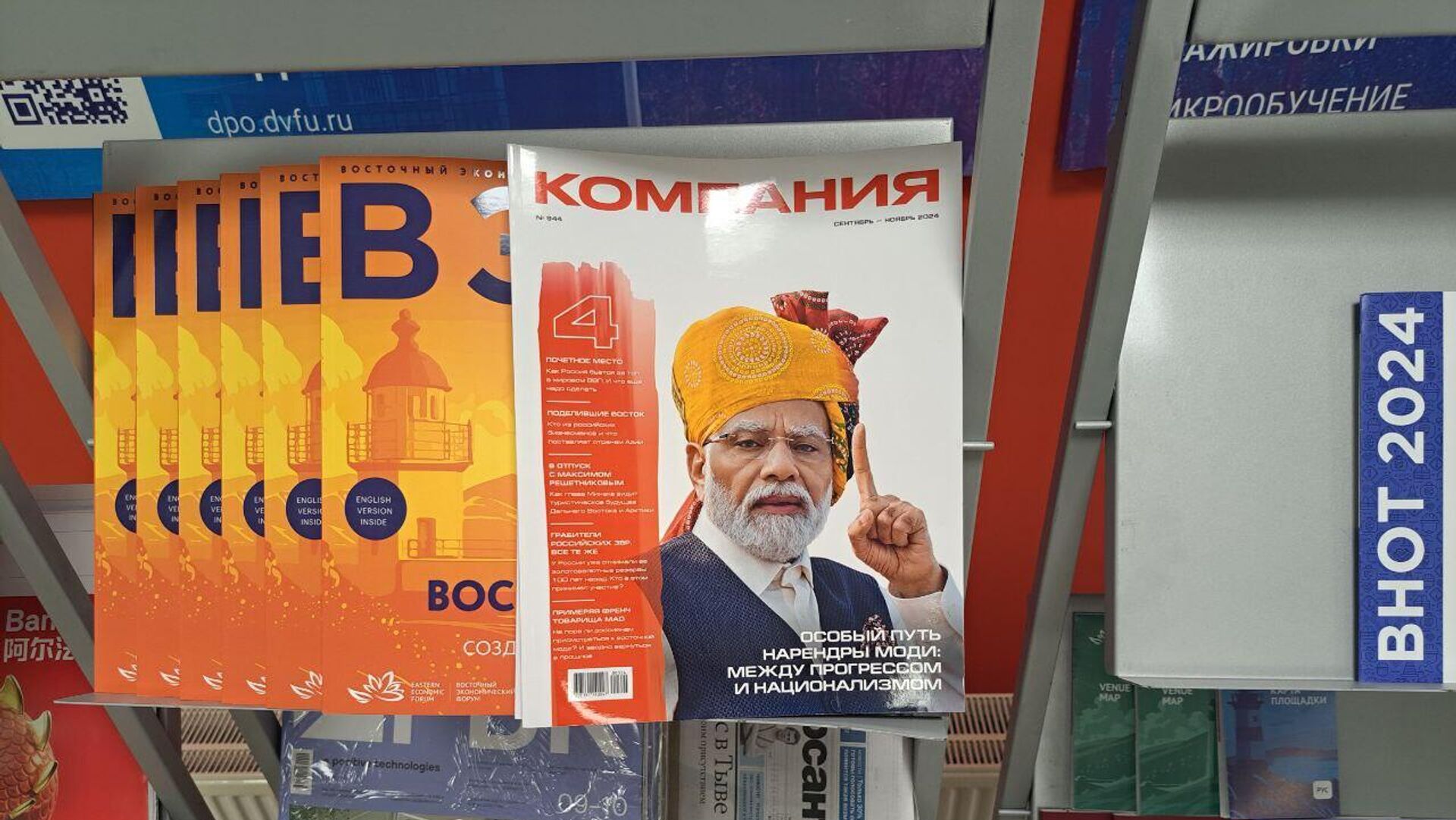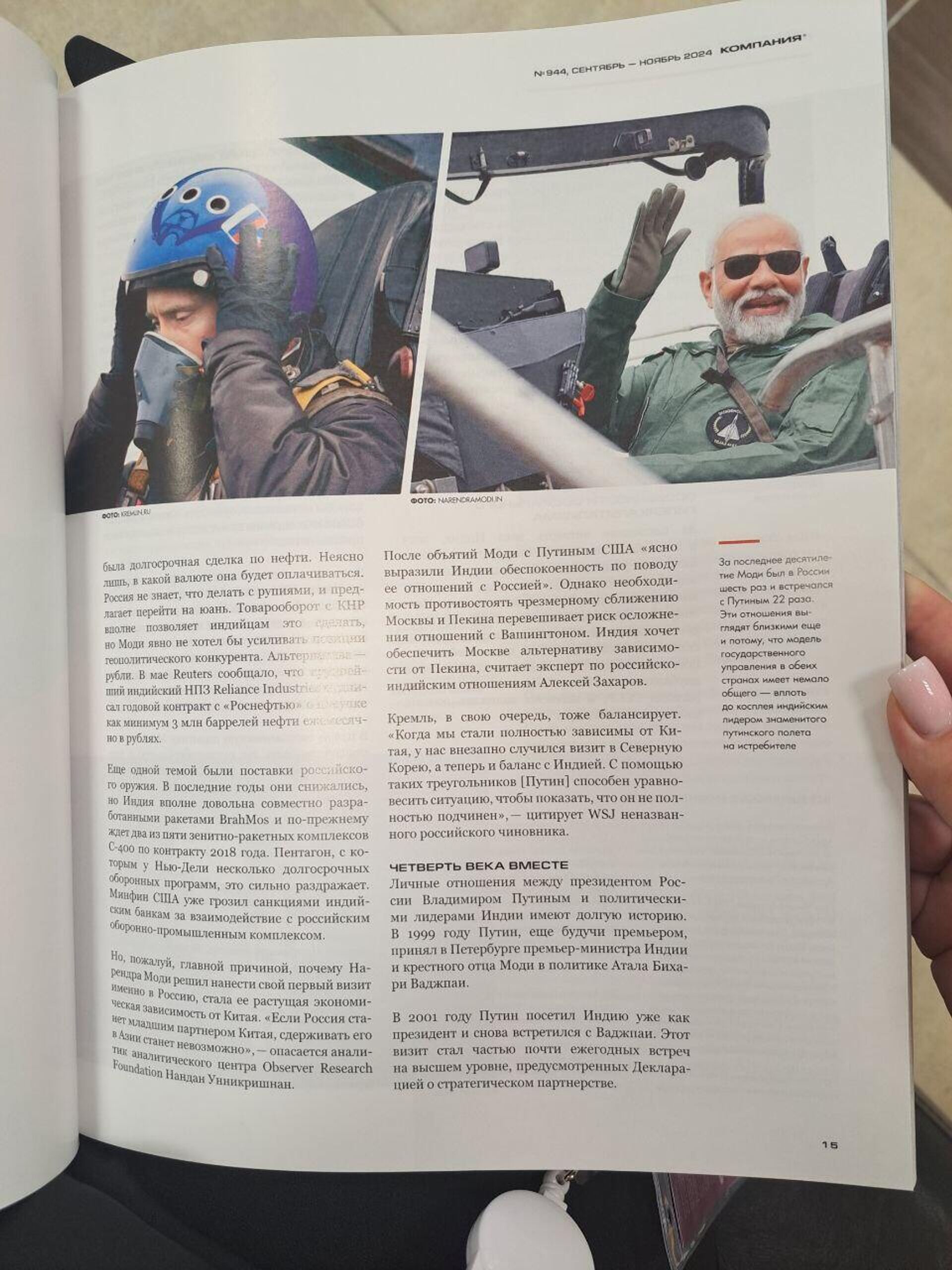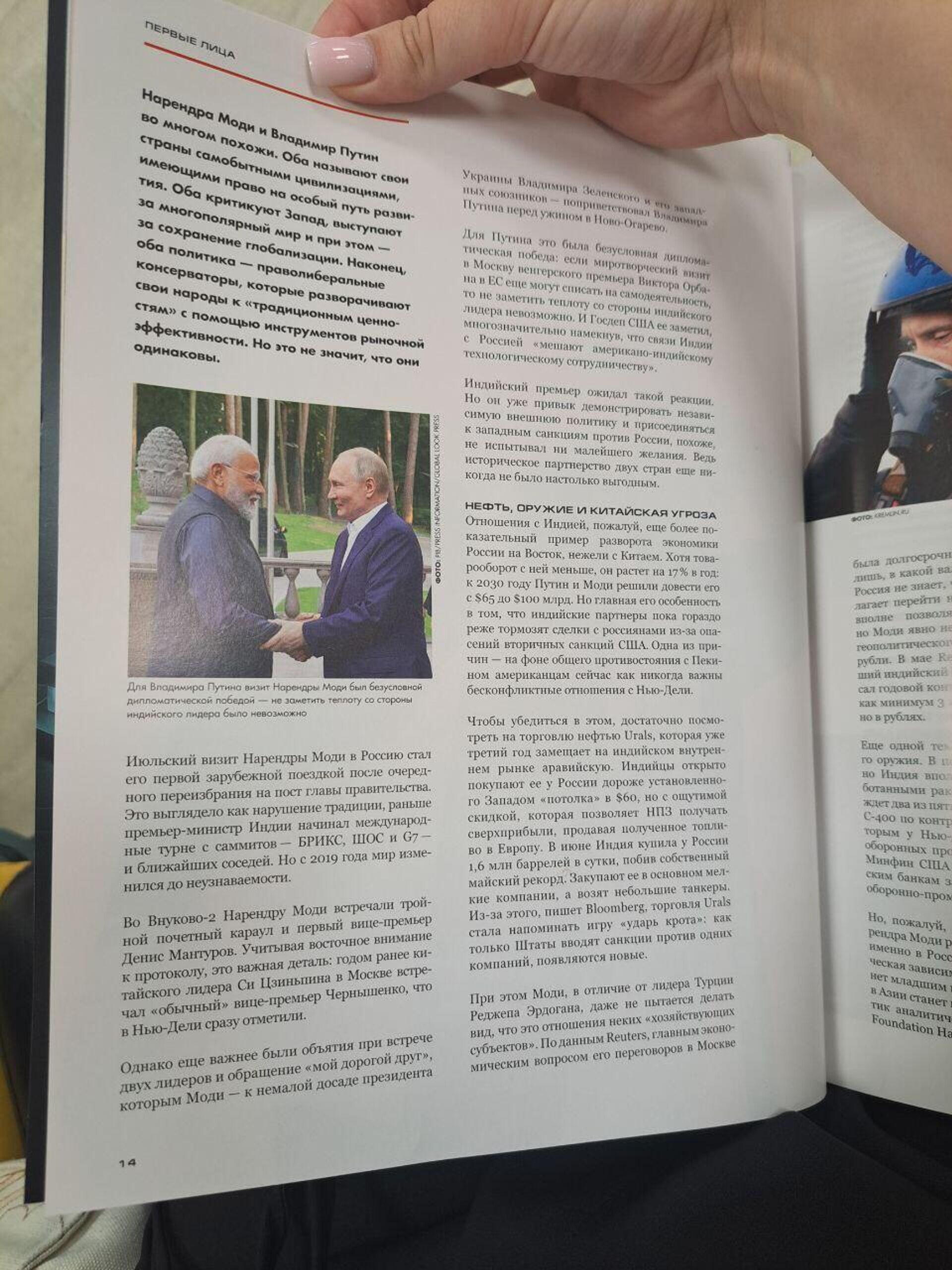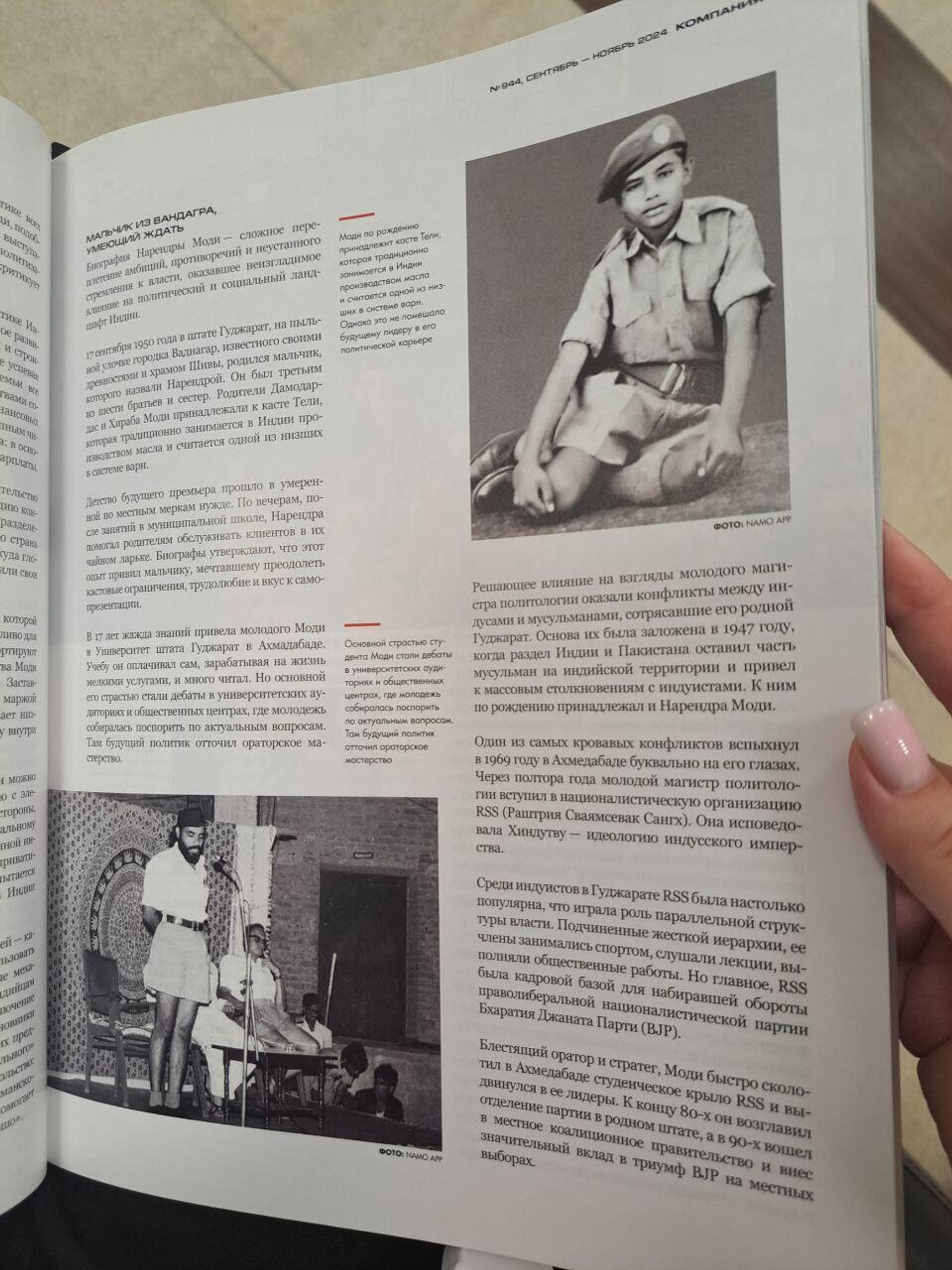https://sputniknews.in/20240904/a-friend-of-russia-gujarati-tiger-modi-graces-magazine-cover-at-eastern-economic-forum-8105262.html
A Friend of Russia: 'Gujarati Tiger' Modi Graces Magazine Cover at Eastern Economic Forum
A Friend of Russia: 'Gujarati Tiger' Modi Graces Magazine Cover at Eastern Economic Forum
Sputnik India
Prime Minister Narendra Modi has featured on the cover of Russian magazine Kompania showcased at the ninth Eastern Economic Forum in Vladivostok from 3 to 6 September.
2024-09-04T15:37+0530
2024-09-04T15:37+0530
2024-09-06T17:52+0530
narendra modi
vladimir putin
china
russia
india
nato
european union (eu)
amazon
collective west
us hegemony
https://cdn1.img.sputniknews.in/img/07e8/09/04/8104819_0:0:1280:721_1920x0_80_0_0_70b05e5c9223447b5bbe78e82952763b.jpg
The cover feature on India's Prime Minister Narendra Modi in a prominent Russian magazine displayed on stands at the ongoing Eastern Economic Forum has created quite a buzz at the annual multinational gathering in Russia's Far Eastern city of Vladivostok.It also draws several parallels between Modi and Russian President Vladimir Putin.It says that both Modi and Putin are focused on bolstering ties with the East and believe in welfare support to help their populations overcome economic difficulties. The article also documents that Modi, much like Putin, wasn't afraid to strengthen India's ties with Washington's adversaries - be it Iran or Myanmar.The story also underlines that it was "impossible not to notice the warmth" displayed by Modi when he met Putin during a visit to Moscow in July this year. It was the Indian leader's first bilateral visit in his 3rd term. Modi addressed Putin as a "friend" during the informal meeting at Russian President's residence in Novo-Ogaryovo on 8 July.Noting the reactions of the US and Volodymyr Zelensky to the Modi-Putin engagement, the magazine stated that the Indian leader had anticipated such a reaction.Further, it noted that Indian refiners and consumers were reaping significant economic benefits from sourcing Russian Urals grade crude, be it through re-exporting of refined products to EU, through controlling inflation or reducing input costs for the Indian industry.It said despite US Treasury's sanctions' threat against foreign banks engaging with Russia's military-industrial complex, defence collaboration between New Delhi and Moscow would continue to grow in coming years. It reckoned that one of the factors was that New Delhi didn't want to become entirely dependent on the West for defence supplies, despite growing ties in recent years.China Factor in India-Russia TiesMeanwhile, the article devotes considerable attention to the respective outlooks of India and Russia towards China.It went on to quote Indian analysts expressing concerns that it would be "impossible to contain China in Asia" if Russia became Beijing's "junior partner", a concern often expressed in Indian strategic circles.The article states that India's strategic imperative in countering "excessive rapprochement" between Russia and China outweighs the risks of complicating its ties with Washington, which has been critical of Indo-Russian relations.The magazine says that the Kremlin, to a degree, is also trying to strike a balance.It asserted that Russia’s growing trade levels with India were a much more “illustrative example” of its pivot to Asia rather than the Russia-China strategic partnership.Dwelling on the geoeconomic competition between China and India, the cover noted Bharat's ongoing policy push to attract foreign investments to position itself as the global manufacturing hub. It noted that US foreign direct investment (FDI) in India in 2019 was around $45.9 billion - three times more than in China.The article piece also traces the political journey of PM Modi, from being a Rashtriya Swayamsevak Sangh (RSS) activist in his college days to becoming the chief minister of Gujarat and eventually going on to hold India’s top executive post.
china
russia
india
ladakh
global south
middle east
russia's far east
vladivostok
Sputnik India
feedback.hindi@sputniknews.com
+74956456601
MIA „Rossiya Segodnya“
2024
Dhairya Maheshwari
https://cdn1.img.sputniknews.in/img/07e6/0c/13/138962_0:0:641:640_100x100_80_0_0_2cb44360dbcdf6d84bf4b299cd045917.jpg
Dhairya Maheshwari
https://cdn1.img.sputniknews.in/img/07e6/0c/13/138962_0:0:641:640_100x100_80_0_0_2cb44360dbcdf6d84bf4b299cd045917.jpg
News
en_IN
Sputnik India
feedback.hindi@sputniknews.com
+74956456601
MIA „Rossiya Segodnya“
Sputnik India
feedback.hindi@sputniknews.com
+74956456601
MIA „Rossiya Segodnya“
Dhairya Maheshwari
https://cdn1.img.sputniknews.in/img/07e6/0c/13/138962_0:0:641:640_100x100_80_0_0_2cb44360dbcdf6d84bf4b299cd045917.jpg
modi news, modi putin summit, russia india relations, russia india news, eastern economic forum, brics summit, brics expansion, g7 sanctions, western sanctions against russia, ukraine russia war, ukraine russia news, modi ukraine visit, us regime change india, us ambassador opposition leaders, rss modi, russia india trade, brics dedollarisation, act east policy, russian defence exports, china india ties, sino-india standoff, ladakh border dispute
modi news, modi putin summit, russia india relations, russia india news, eastern economic forum, brics summit, brics expansion, g7 sanctions, western sanctions against russia, ukraine russia war, ukraine russia news, modi ukraine visit, us regime change india, us ambassador opposition leaders, rss modi, russia india trade, brics dedollarisation, act east policy, russian defence exports, china india ties, sino-india standoff, ladakh border dispute
A Friend of Russia: 'Gujarati Tiger' Modi Graces Magazine Cover at Eastern Economic Forum
15:37 04.09.2024 (Updated: 17:52 06.09.2024) Prime Minister Narendra Modi is featured on the cover of the Russian magazine Kompania, showcased at the Eastern Economic Forum (EEF) in Vladivostok. 'Narendra Modi's Unique Path: Balancing Progress & Nationalism', reads the title of the story, which praises the Indian leader for refusing to buckle under Western pressure.
The cover feature on India's Prime Minister Narendra Modi in a prominent Russian magazine displayed on stands at the ongoing
Eastern Economic Forum has created quite a buzz at the annual multinational gathering in Russia's Far Eastern city of Vladivostok.
An extensive article describes Modi as a "Gujarati tiger" and a "friend of Russia", praising the 73-year-old leader for supporting the quest for a multipolar world, globalisation and refusing to buckle under western pressure.
It also draws several parallels between Modi and Russian President Vladimir Putin.
"Both call their countries original civilizations that have the right to a special path of development. Both criticize the West, advocate a multipolar world and at the same time support the preservation of globalization. Finally, both politicians are right-wing liberal conservatives who turn their people towards traditional values using instruments of market efficiency," the magazine states.
It says that both Modi and Putin are focused on bolstering ties with the East and believe in welfare support to help their populations overcome economic difficulties. The article also documents that Modi, much like Putin, wasn't afraid to strengthen India's ties with Washington's adversaries - be it Iran or Myanmar.
Highlighting the excellent rapport shared between the twi, the article stresses that Modi has visited Russia on six occasions since 2014 and met Putin 22 times during the same period
The story also underlines that it was "
impossible not to notice the warmth" displayed by Modi when he met Putin
during a visit to Moscow in July this year. It was the Indian leader's first bilateral visit in his 3rd term. Modi addressed Putin as a "
friend" during the informal meeting at Russian President's residence in Novo-Ogaryovo on 8 July.
The article describes Modi's visit to Moscow as an "absolute and unconditional diplomatic victory" for Putin, as it was a slap on the face of NATO allies who claim to have successful in isolating Russia.
Noting the
reactions of the US and Volodymyr Zelensky to the Modi-Putin engagement, the magazine stated that the Indian leader had anticipated such a reaction.
"But he had already been accustomed to demonstrating an independent foreign policy and did not seem to have the slightest desire to join Western sanctions against Russia. After all, the historical partnership between the two countries has never been so beneficial," the magazine said, noting that bilateral trade has surged to a record of $65 billion last fiscal and both the leaders have set a $100 billion turnover target by 2030.
Further, it noted that Indian refiners and consumers were reaping significant economic benefits from sourcing Russian Urals grade crude, be it through re-exporting of refined products to EU, through controlling inflation or reducing input costs for the Indian industry.
At the same time, the cover story expressed optimism about continued resilience of Russia-India defence partnership, noting that India was quite happy the way things have been progressing on the front, especially the joint development of the BrahMos missile.
It said despite US Treasury's sanctions' threat against foreign banks engaging with Russia's military-industrial complex,
defence collaboration between New Delhi and Moscow would continue to grow in coming years. It reckoned that one of the factors was that New Delhi didn't want to become entirely dependent on the West for defence supplies, despite growing ties in recent years.
China Factor in India-Russia Ties
Meanwhile, the article devotes considerable attention to the respective outlooks of India and Russia towards China.
"But, perhaps, the main reason why Narendra Modi decided to make his first visit to Russia was its growing economic dependence on China," the magazine analysed.
It went on to quote Indian analysts
expressing concerns that it would be "impossible to contain China in Asia" if Russia became Beijing's "junior partner", a concern often expressed in Indian strategic circles.
The article states that India's strategic imperative in countering "excessive rapprochement" between Russia and China outweighs the risks of complicating its ties with Washington, which has been critical of Indo-Russian relations.
"India wants to provide Moscow with an alternative to dependence on Beijing," Alexei Zakharov, an expert on Russian-Indian relations, is quoted as saying.
The magazine says that the Kremlin, to a degree, is also trying to strike a balance.
"When we became completely dependent on China, we suddenly had a visit to North Korea, and now we have a balance with India. With these triangles, [Putin] is able to balance the situation to show that he is not completely subordinate,” it cites unnamed Russian officials as telling US media.
It asserted that
Russia’s growing trade levels with India were a much more “illustrative example” of its
pivot to Asia rather than the Russia-China strategic partnership.
Dwelling on the geoeconomic competition between China and India, the cover noted Bharat's ongoing policy push to attract foreign investments to position itself as the global manufacturing hub. It noted that US foreign direct investment (FDI) in India in 2019 was around $45.9 billion - three times more than in China.
"India has all the conditions to jump on the last car of the demographic transition and replace China in the international labor division market by mid-century. After all, the population of the latter is expected to halve by the end of the century, to 600 million people, while in India it should exceed 1.7 billion," it said.
The article piece also traces the political journey of PM Modi, from being a Rashtriya Swayamsevak Sangh (RSS) activist in his college days to becoming the chief minister of Gujarat and eventually going on to hold India’s top executive post.





